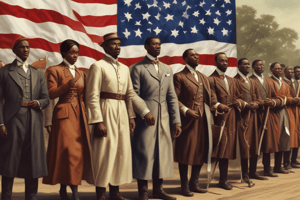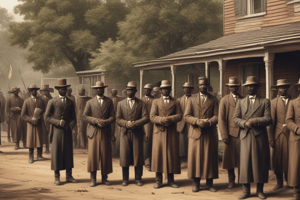Podcast
Questions and Answers
What was the primary goal of President Johnson's Reconstruction Plan?
What was the primary goal of President Johnson's Reconstruction Plan?
Which amendment granted African American men the right to vote?
Which amendment granted African American men the right to vote?
What role did Congress play in the Reconstruction era?
What role did Congress play in the Reconstruction era?
What was a significant challenge faced by African Americans after Reconstruction ended?
What was a significant challenge faced by African Americans after Reconstruction ended?
Signup and view all the answers
Which group instigated violence and intimidation against African Americans during Reconstruction?
Which group instigated violence and intimidation against African Americans during Reconstruction?
Signup and view all the answers
Study Notes
Reconstruction Overview
- Reconstruction aimed to address the challenges of reuniting the nation after the Civil War.
- The process involved political, social, and economic strategies to reintegrate Southern states.
Freedom for African Americans
- Formerly enslaved individuals sought civil rights and autonomy post-emancipation.
- The goal was to secure equal opportunities in education, employment, and legal matters.
President Johnson's Reconstruction Plan
- Johnson's approach emphasized quick restoration of Southern states with minimal conditions.
- His lenient policies faced criticism for allowing former Confederates to regain power.
Opposition to President Johnson
- Congressional Republicans opposed Johnson's plan, advocating for stronger federal intervention.
- Disagreements centered on civil rights for freed slaves and the conditions for Southern reintegration.
Fourteenth Amendment
- Ratified in 1868, it granted citizenship and equal protection under the law to all born in the U.S.
- Aimed to address issues of civil rights for African Americans post-war.
Congress Takes Control of Reconstruction
- Congressional Republicans passed legislation that strengthened civil rights and aimed to reduce Southern political influence.
- This change marked a shift in power dynamics, as Congress sought to enforce Reconstruction policies.
Fifteenth Amendment
- Ratified in 1870, it prohibited denying the right to vote based on race or color.
- This amendment aimed to secure voting rights for African American men.
Reconstruction Governments
- New state governments were established in the South, often with significant African American participation.
- These governments faced opposition and violence from white supremacist groups.
Ku Klux Klan
- A secret society formed to intimidate and suppress African Americans and their allies.
- Engaged in violent acts to undermine Reconstruction efforts and restore white control.
Reconstruction Ends
- By the mid-1870s, federal support for Reconstruction waned, leading to the collapse of revolutionary reforms.
- Southern states slowly regained autonomy, reverting to pre-war power structures.
Rebuilding Southern Industry
- Focus on economic diversification in the South, moving beyond an agriculture-based economy.
- Efforts included promoting industries such as textiles and railroads to stimulate economic recovery.
Reconstruction in the North
- Northern states continued to grapple with the implications of Reconstruction, including debates over civil rights.
- Economic interests and labor dynamics influenced attitudes toward Southern Reconstruction efforts.
Studying That Suits You
Use AI to generate personalized quizzes and flashcards to suit your learning preferences.
Description
Test your understanding of Module 2 on Reconstruction. This quiz covers key concepts such as the challenges of rebuilding the South, the experiences of African Americans, and President Johnson's Reconstruction Plan. Dive deep into the successes and failures that shaped this pivotal era in American history.




